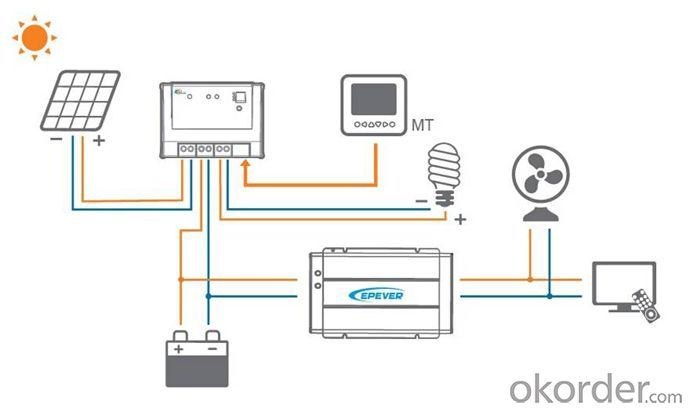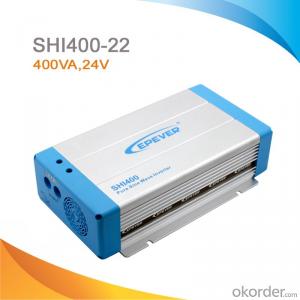Off-Grid Pure Sine Wave Solar Inverter/Power Inverter 400W, DC 24V to AC 220V/230V SHI400-22
- Loading Port:
- China Main Port
- Payment Terms:
- TT or LC
- Min Order Qty:
- -
- Supply Capability:
- -
OKorder Service Pledge
OKorder Financial Service
You Might Also Like
SHI series is a pure sine wave inverter which can convert 12/24/48Vdc to 220/230Vac 50/60Hz based on full digital and intelligent design. It features high reliability, high efficiency, concise outline, small volume, easy installation and operation. The inverter can be applied in many fields, such as household appliances, electric tools and industrial devices etc, especially for solar photovoltaic power system.
True sine wave inverters produce power that is either identical or sometimes slightly better to power from the public utility power grid system. The power wave when viewed through an oscilloscope is a smooth sine wave.
Features:
·Input & output fully isolation
·Adoption of advanced SPWM technology, pure sine wave output
·Dynamic current loop control technology to ensure inverter reliable operation
·Wide DC input voltage range
·The output voltage and frequency can be switched
·Low output harmonic distortion(THD≤3%)
·LED indicators for input voltage range, load power range, normal output & failure state
·Optional energy saving mode
·Wide working temperature range (industrial level)
·Continuous operation at full power
Protections:
·Output short circuit protection
·Overload protection
·Input low voltage protection
·Input over voltage protection
·Overheating protection
·Inverter abnormal protection

Specification:
Types | SHI400-12 | SHI400-22 | SHI600-12 | SHI600-22 | SHI1000-22 | SHI1000-42 |
Nominal Battery Voltage | 12V | 24V | 12V | 24V | 24V | 48V |
Input Voltage Range | 10.8~16Vdc | 21.6~32Vdc | 10.8~16Vdc | 21.6~32Vdc | 21.6~32Vdc | 43.2~64Vdc |
No Load Current | ≤0.8A | ≤0.45A | ≤0.7A | ≤0.45A | ≤0.45A | ≤0.35A |
Output Wave | Pure Sine Wave | |||||
Output Voltage | 220Vac±3% / 230Vac±10% | |||||
Continuous Power | 400W | 600W | 1000W | |||
Power 10 sec | 600W | 900W | 1500W | |||
Power 1.5 sec | 800W | 1200W | 2000W | |||
Surge Power | 900W | 1350W | 2250W | |||
Frequency | 50/60Hz±0.2% | |||||
Distortion THD | ≤ 3% (resistive load) | |||||
Efficiency at Rated Power | ≥91% | ≥92% | ≥91% | ≥92% | ≥93% | ≥93.5% |
Max. Efficiency | ≥92% | ≥93% | ≥93% | ≥94% | ≥94% | ≥94% |
Terminal | 16mm2 | 25mm2 | 25mm2 | |||
Dimensions | 280×166×74.3mm | 295×186×82mm | 295×208×98mm | |||
Installation | 150×158mm | 150×178mm | 150×200mm | |||
Hole Size | Φ5mm | Φ6mm | Φ6mm | |||
Net Weight | 1.8kg | 2.3kg | 3.3kg | |||
Working Temperature | -20℃~ +50℃ | |||||
Storage Temperature | -35℃~ +70℃ | |||||
Humidity | < 95% (N.C.) | |||||
Altitude | < 5000m(Derating to operate according to IEC62040 at a height exceeding 1000m) | |||||
Insulation Resistance | Between DC input terminals and metal case: ≥550MΩ; Between AC output terminals and metal case: ≥550MΩ. | |||||
Dielectric Strength | Between DC input terminals and metal case: Test voltage AC1500V, 1 minute Between AC output terminals and metal case: Test voltage AC1500V, 1 minute | |||||
- Q:What is the role of a power management system in a solar inverter?
- The role of a power management system in a solar inverter is to efficiently convert and manage the electricity generated from solar panels. It regulates the flow of power, optimizes energy production, and ensures the safe and reliable operation of the solar inverter system. Additionally, it provides protection against overvoltage, overcurrent, and other electrical faults, maximizing the overall performance and longevity of the system.
- Q:Can a solar inverter be used with a solar-powered water desalination system?
- Yes, a solar inverter can be used with a solar-powered water desalination system. A solar inverter is responsible for converting the DC power generated by solar panels into AC power that can be used by electrical devices. In the case of a solar-powered water desalination system, the solar panels generate DC power, which is then converted into AC power by the inverter to run the system's pumps, filters, and other electrical components. This allows the system to operate efficiently using clean and renewable energy from the sun.
- Q:What is the role of a display or user interface in a solar inverter?
- The role of a display or user interface in a solar inverter is to provide users with real-time information about the performance, status, and operational parameters of the inverter system. It allows users to monitor the energy production, voltage levels, current flow, and any potential faults or errors. Additionally, the user interface enables users to configure and control various settings of the solar inverter, such as output power limits, grid synchronization, and system diagnostics.
- Q:Can a solar inverter be used with a solar-powered street lighting system?
- Yes, a solar inverter can be used with a solar-powered street lighting system. A solar inverter is responsible for converting the DC power generated by solar panels into AC power, which is necessary for powering street lights. By integrating a solar inverter, the solar-powered street lighting system can efficiently convert and utilize the energy generated by the solar panels, ensuring the proper functioning of the lights.
- Q:How does a solar inverter handle reverse power flow?
- A solar inverter handles reverse power flow by automatically detecting the excess power generated by the solar panels and diverting it to the utility grid. This process, known as anti-islanding, ensures a safe and efficient operation of the solar system by preventing overloading and potential damage to the inverter.
- Q:What is the lifespan of the capacitors in a solar inverter?
- The lifespan of capacitors in a solar inverter can vary depending on various factors, such as the quality of the components, operating conditions, and maintenance. Generally, high-quality capacitors can have a lifespan of around 10 to 15 years. However, it is important to regularly monitor and maintain the inverter to ensure optimal performance and longevity of the capacitors.
- Q:How do you connect a solar inverter to a data monitoring system?
- To connect a solar inverter to a data monitoring system, you need to follow a few steps. First, ensure that your solar inverter is compatible with a data monitoring system. Next, connect the inverter to a local network, either wired or wireless, depending on the available options. Then, configure the inverter's settings to enable data transmission. Finally, install the required software or app provided by the data monitoring system and use the provided instructions to link the inverter to the monitoring system.
- Q:What is the role of a power optimizer in a solar inverter?
- The role of a power optimizer in a solar inverter is to maximize the energy output of each individual solar panel in a solar power system. It works by continuously monitoring and optimizing the performance of each panel, ensuring that it operates at its maximum power point. This helps to overcome shading, mismatch, and other factors that can negatively impact the overall system efficiency. By optimizing the power output of each panel, power optimizers enhance the overall energy production of the solar power system, leading to increased electricity generation and improved system performance.
- Q:Are solar inverters compatible with smart home systems?
- Yes, solar inverters are compatible with smart home systems. Many modern solar inverters are designed to integrate with smart home technologies, allowing homeowners to monitor and control their solar energy production and usage remotely through their smart devices. This integration enables seamless integration of solar power into the overall smart home system, providing more efficient energy management and greater control over energy consumption.
- Q:Are all solar inverters compatible with all solar panels?
- No, not all solar inverters are compatible with all solar panels. The compatibility between solar inverters and panels depends on various factors such as the voltage, current, and type of panels being used, as well as the specifications and requirements of the specific inverter model. It is important to ensure that the inverter is compatible with the specific type and configuration of solar panels being installed to ensure optimal performance and efficiency.
1. Manufacturer Overview |
|
|---|---|
| Location | |
| Year Established | |
| Annual Output Value | |
| Main Markets | |
| Company Certifications | |
2. Manufacturer Certificates |
|
|---|---|
| a) Certification Name | |
| Range | |
| Reference | |
| Validity Period | |
3. Manufacturer Capability |
|
|---|---|
| a)Trade Capacity | |
| Nearest Port | |
| Export Percentage | |
| No.of Employees in Trade Department | |
| Language Spoken: | |
| b)Factory Information | |
| Factory Size: | |
| No. of Production Lines | |
| Contract Manufacturing | |
| Product Price Range | |
Send your message to us
Off-Grid Pure Sine Wave Solar Inverter/Power Inverter 400W, DC 24V to AC 220V/230V SHI400-22
- Loading Port:
- China Main Port
- Payment Terms:
- TT or LC
- Min Order Qty:
- -
- Supply Capability:
- -
OKorder Service Pledge
OKorder Financial Service
Similar products
New products
Hot products
Hot Searches
Related keywords































